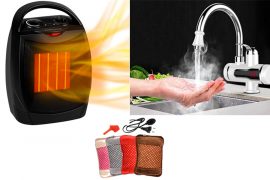Do you wonder why your plants are not growing to their full potential? Do you wonder why your plants turn brown and eventually die? Well, one of the common problems is your pot. The shape of the pot and size of the pot highly matters in the growth of your plants. Either shrubs or trees, all types of plants need different types of pots. If you are new to the gardening session or are just a plant enthusiast, then keep on reading to know how the pots affect the growth of the plant.
There are two main things to consider while buying a pot. One is you have to think about the type of plant you are getting. Shrubs, annuals, perennials, succulents or small trees, these all define what type of pot you need to buy. The second is how deep the root of the plants grows. Over time, your plants will grow and so will the roots. So you have to think how far the roots grow. The more the roots grow, the wider-base pot you need.
Planting large plants in small pots can leave the roots be pot bound which means the soil will dry quickly. Hence, the growth of the plant will be hampered. Similarly, planting small plants in large pots means excess moisture will be collected at the bottom which will lead the roots to rot. Also, a funky wet soil smell will ruin the environment.
Types of Plants
1. Ornamental Plants
Ornamental plants are the plants that are grown for decorative purposes. These can include from small succulents to small trees.
Small Succulents

Succulents are the plants, who have fleshy leaves because they store water. Succulents are planted in less than 6 inches depth of soil.
Annuals

An annual plant is a plant that completes its life cycle in one year. Annuals need to be planted in 12 inches depth of soil.
Perennials

A perennial plant is a plant that lives for more than two years. Perennials need at least 12 to 18 inches depth of soil.
Shrubs

A shrub is smaller than a tree but has many stems and is woody. Shrubs need 18 inches to 2 feet depth of soil.
Small Trees

Small trees are the trees which don’t grow too tall and are perfect to plant at a home. Small trees need 2 to 3 feet depth of soil.
2. Edible Plants
As the name suggests, edible plants are the plants that are consumed by humans. For edible plants, the more there is room to grow, the better it is.
Herbs

Herbs are used for flavouring and garnishing foods. Herbs planted indoors need 6-inch depth of soil and for those planted outside need 12-inch depth of soil.
Shallow Rooting Crops

Shallow rooting crops are those crops whose roots lie close to the surface of the soil. For example, corn, garlic, lettuce, radish are some shallow rooting crops. These crops need 6-12 inches of depth of soil.
Medium Size (Medium Rooting)

Medium sized crops such as eggplants, peppers, squashes, and cucumbers need 12-18 inches of depth of soil.
Large Scale (Deep Rooting)

Large Scale crops such as potatoes, tomatoes, and watermelons need 18 inch – 2 feet of depth of soil.
Citrus and Fruit Trees

These types of trees need 2 – 3 feet of depth of soil.
Shape of Pot
1. Round, Square and Rectangular

These types of pots can hold up to 12 inches to 3 feet of soil. Perennials, shrubs and small trees are great for these types of pots.
2. Shallow

A shallow pot can hold up to less than 6 inches of depth of soil. These type of pot can hold small succulents. These pots are great for outdoor side tables and dining tables. Even your work table can be glammed up by their presence.
3. Vase-shaped

A vase-shaped pot is what we usually see and have. The opening of the pot is flared out so this pot is used to grow mixtures of annuals, perennials, evergreen shrub and small trees.
4. Urn-shaped

Opposite of vase-shaped, urn-shaped pots are wide at the bottom and have a tight neck. These types of pots are used to grow annuals and perennials. Shrubs, Vine and small trees can also be grown if you think of not repotting them ever.
5. Tall and Upright

As the name suggests, these types of pot are tall and skinny. These pots are great for corners. Be careful in planting shallow-rooted crops in these types of pots.
When to Repot

Repotting is a crucial process in gardening if you want eye-pleasing and healthy plants.
If your plants look overgrown and look no longer proportional to the pot, then it is time to shift the plant to a new home.
If the water runs out quickly, that means there is no more space for the root, as it is growing. Change the plant to a bigger pot.
If the plants show signs of stress, are turning yellow or brown, and if the plant has stopped growing at its normal rate, then it is time to repot and maybe change the soil as well.
How to Repot

Loosen up the soil in the pot to a few depths without hurting the roots.
Fill the new pot with soil.
After you take out the plant from the old pot, place it in the new pot as quickly as possible.
Add soil and water the soil.
Hope these ideas and tips will help you flourish your garden area. Also, it is the perfect time to change the pots and also add some flowers after all Spring is here.
Thanks for reading! I’d really appreciate it if you recommend this post (by sharing ) so other people can find it.
Also if you are looking to invest in properties, head over Basobaas.com for some awesome selections.







